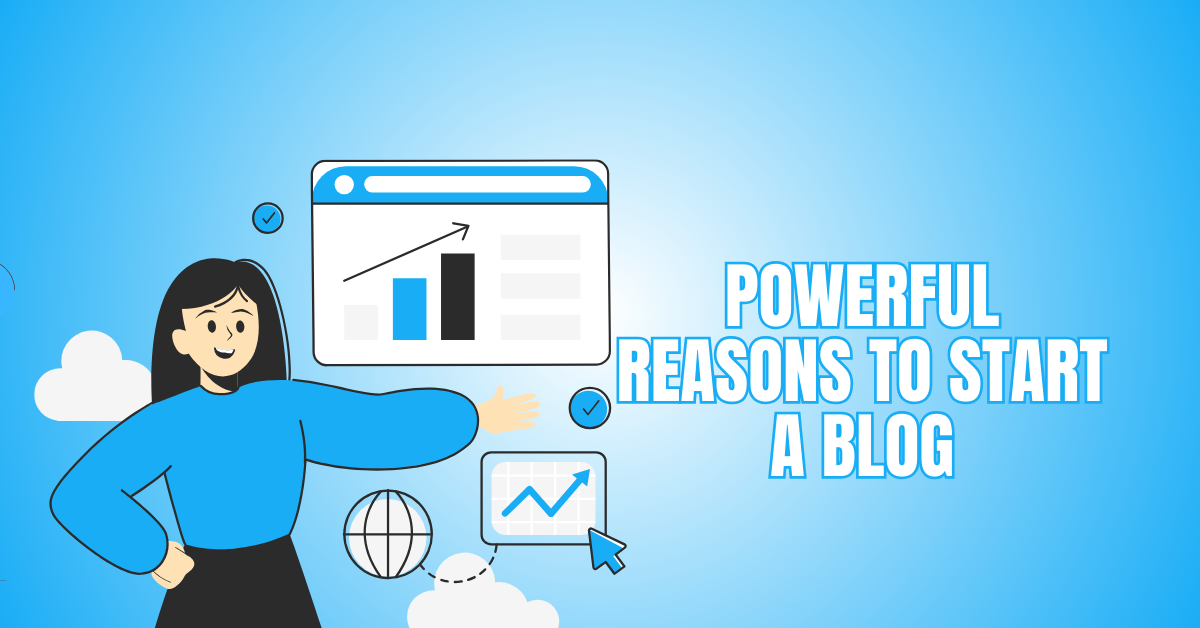Powerful Reasons To Start A Blog Today & Transform Your Life
Starting a blog is one of the smartest moves you can make today. As you will see in this blog post, there are many benefits to starting a blog.
Whether to share your passion, grow your brand, or create income, the reasons to start a blog are truly inspiring.
This article explores powerful benefits that show why launching your blog now can open doors to creativity, connection, and success like never before.
Benefits Of Starting A Blog
1. Express Your Passion And Creativity
Blogging allows you to freely explore topics that inspire you—be it food, fitness, tech, or travel. It’s a dedicated space where your unique voice matters.
Over time, it becomes more than a hobby; it becomes a personal outlet to share your experiences, ideas, and creative energy.
Why It’s Powerful
According to Orbit Media, 77% of bloggers report that blogging drives results. Expressing your thoughts improves mental well-being, strengthens self-awareness, and builds community.
Creative self-expression through blogging helps sharpen your communication, expand your influence, and connect with people who genuinely care about the same passions you do.
2. Build Your Brand
One of the strongest reasons to start a blog is to create and showcase your brand in the digital world. Your blog reflects your values, expertise, and personality, shaping how others perceive you long before you meet. You highlight what makes you unique in your industry or niche through thoughtful content and a consistent voice.
Why It’s Powerful
A CareerBuilder survey revealed 70% of employers screen candidates online. A professional blog boosts visibility, establishes credibility, and builds trust.
It acts like a live résumé, showcasing your skills and authority, helping you attract the right clients, collaborators, or opportunities.
3. Enhance Your Writing And Communication Skills
Blogging helps you communicate better by encouraging clarity, structure, and thoughtful expression. Whether explaining complex ideas or telling stories, consistent writing improves grammar, voice, and flow.
These transferable skills benefit your work presentations, everyday conversations, and professional interactions across every area of life and career.
Why It’s Powerful
According to the National Association of Colleges and Employers, strong writing skills increase employability and can raise salaries by up to 20%.
Blogging sharpens your skills in persuasion, storytelling, and clarity. These abilities give you a competitive edge in nearly every career and business opportunity.
4. Create A Source Of Passive Income
A blog can become a money-making asset through affiliate marketing, ads, sponsorships, digital products, and courses. Once your blog has steady traffic, older posts keep generating income. Over time, you can earn even while offline, creating a flexible, sustainable income with unlimited growth potential.
Why It’s Powerful
Data from ConvertKit shows 30% of bloggers monetize their blogs, and 10% earn over $1,000 monthly. Blogging gives you financial freedom while doing what you love.
With strategic planning and consistency, your content works for you long after it's published, making blogging a trustworthy passive income source.
5. Become An Authority In Your Niche
Consistently blogging about your area of expertise—whether it's fitness, finance, travel, or design—positions you as a trusted resource.
As your content grows, readers view you as a knowledgeable leader. This opens doors to exciting collaborations, media attention, speaking engagements, and increased influence within your chosen industry or community.
Why It’s Powerful
Demand Metric reports that 81% of consumers trust blog content. Becoming an authority helps you build trust, attract loyal followers, and grow your influence.
People turn to experts they recognize. Through consistent value sharing, your blog makes you visible, credible, and positioned for career or business growth.
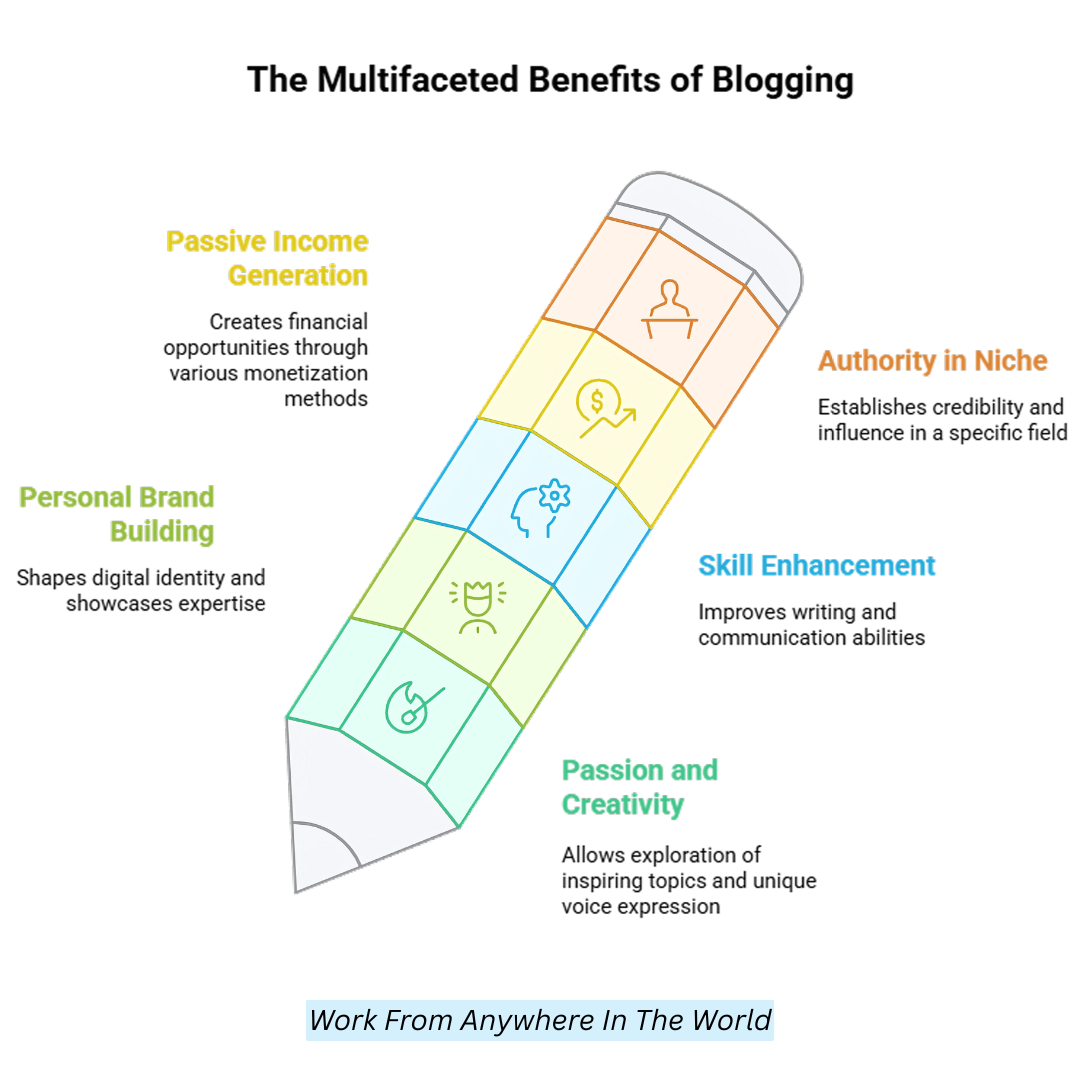
6. Connect With Like-Minded People
One of the rewarding reasons to start a blog is the opportunity to connect with people who share your interests and values.
Your audience becomes a source of inspiration and collaboration through comments, emails, and social media. These connections can blossom into lifelong friendships, partnerships, or creative ventures supporting your personal and professional growth.
Why It’s Powerful
According to GrowthBadger, 65% of high-income bloggers actively network with other bloggers. This networking leads to joint ventures, interviews, co-hosted webinars, and community-building that fuel growth.
Meaningful online connections boost visibility and motivation, making blogging a gateway to valuable relationships.
7. Learn Valuable Tech And Marketing Skills
Running a blog teaches you practical skills like SEO, WordPress, Google Analytics, email campaigns, and content marketing. You’ll also master social media strategy and user experience.
These competencies are transferable to nearly every career or business field, making blogging one of today's most hands-on digital learning tools.
Why It’s Powerful
HubSpot reports that 64% of marketers actively invest in SEO and blogging. As you grow your blog, you develop sought-after digital skills that can boost job prospects, freelance opportunities, and business success, equipping you with a versatile toolkit for the modern workforce.
8. Document Your Life Journey
Blogs can act as personal archives. Whether you're tracking fitness goals, travel experiences, parenting milestones, or entrepreneurial growth, blogging helps preserve your story.
Revisiting old posts reminds you how far you’ve come and what lessons you’ve learned, turning your personal development into a public or private timeline.
Why It’s Powerful
A study by Psychology Today highlights that journaling improves memory and mood. Blogging similarly allows for structured reflection.
Your posts become a legacy—something you, your community, and future generations can look back on, offering insight, encouragement, and a sense of purpose over time.
9. Improve Mental Clarity And Focus
Blogging requires organized thinking. Turning ideas into posts helps you clarify your beliefs, sort through emotions, and articulate your values.
This reflection process improves focus and leads to sharper decision-making and a more confident understanding of who you are and what truly matters to you.
Why It’s Powerful
According to a University of Texas study, expressive writing improves cognitive function and emotional processing. Blogging similarly acts as therapy, allowing you to process thoughts and find clarity. The more you write, the more focused, grounded, and self-aware you become daily.
10. Create A Launchpad For Business Or Products
One of the key reasons to start a blog is that it serves as a powerful launchpad for businesses, products, or services. As your readership grows, you build trust and authority, turning your engaged audience into loyal customers ready to support online courses, books, merchandise, or coaching. Your blog becomes the solid foundation of your brand.
Why It’s Powerful
Data from Blog Tyrant shows that 25% of bloggers start blogs to support business goals. A loyal blog following responds better than cold leads, making conversions easier and more cost-effective. With the right content, your blog transforms into a sustainable marketing engine for product launches.
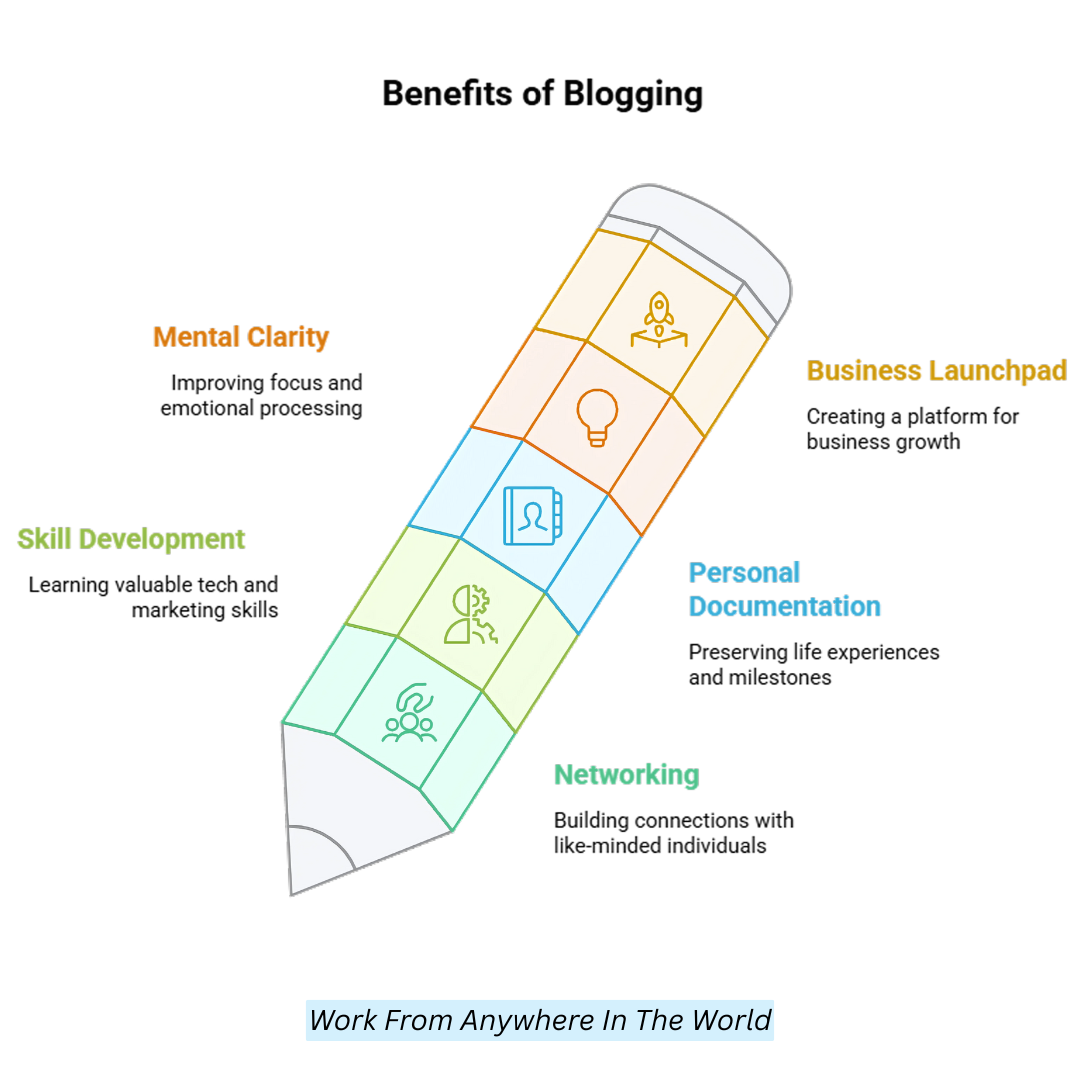
11. Boost Career Opportunities
Blogging showcases your expertise, personality, and passions beyond a traditional resume. When recruiters or hiring managers Google you, your blog presents a professional, thoughtful, and engaged candidate.
It highlights communication skills, initiative, and consistent effort, setting you apart from others who may only rely on a static LinkedIn profile.
Why It’s Powerful
According to Zippia, 70% of employers use social media to screen candidates. A well-maintained blog can be your edge.
It demonstrates discipline, creativity, and industry knowledge—qualities that leave a strong impression and often result in callbacks, interviews, or freelance gigs that never appear on job boards.
12. Gain Confidence Through Sharing
Hitting “publish” on your ideas can feel intimidating, but each blog post builds self-trust. You learn that your insights matter and that others value your experiences.
With every article, confidence grows—not just in your writing, but in your ability to express and stand behind your unique voice.
Why It’s Powerful
PsychCentral states that self-expression enhances confidence and reduces anxiety. Blogging is a public act of courage and clarity.
As your audience grows and responds positively, it reinforces your worth and belief in your voice, empowering you socially, professionally, and personally through consistent self-affirmation.
13. Practice Goal Setting And Discipline
Blogging isn’t just creative—it’s a productivity system. Setting a content schedule, meeting deadlines, and sticking to a vision cultivates strong habits.
Over time, you’ll develop better time management, long-term planning, and commitment. This structure naturally spills into other areas of your life, helping you become more effective overall.
Why It’s Powerful
A study in American Psychologist found that goal setting improves performance by 20–25%. Blogging forces you to plan, act, and reflect consistently, leading to increased self-discipline, stronger follow-through, and measurable personal or professional growth with each post you create and complete.
14. Build A Portfolio Of Work
If you're a creative professional, your blog becomes your living, breathing portfolio. Whether you're a writer, designer, or developer, it shows your process, results, and unique style.
Unlike static resumes, a blog evolves with your skills, helping clients, employers, and collaborators see your talent in real time.
Why It’s Powerful
A LinkedIn study shows that 69% of professionals believe a strong online portfolio helps them land better opportunities.
Blogs provide real-world examples of what you can do—proof that builds trust. It’s not just what you say you can do; it’s what you’ve already done and shared with the world.
15. Travel And Experience Opportunities
One of the exciting reasons to start a blog is the chance to unlock unique travel and experience opportunities. Blogging can open doors to press trips, sponsored events, product launches, and collaborations.
Bloggers in niches like travel, food, fashion, parenting, and tech often receive invitations to explore and participate in exclusive experiences that blend creativity with career growth.
Why It’s Powerful
According to Influencer Marketing Hub, 61% of brands collaborate with bloggers and influencers for exposure. With a loyal audience, your blog becomes a magnet for perks, partnerships, and paid adventures, turning your passion into real-world experiences and exciting lifestyle opportunities.
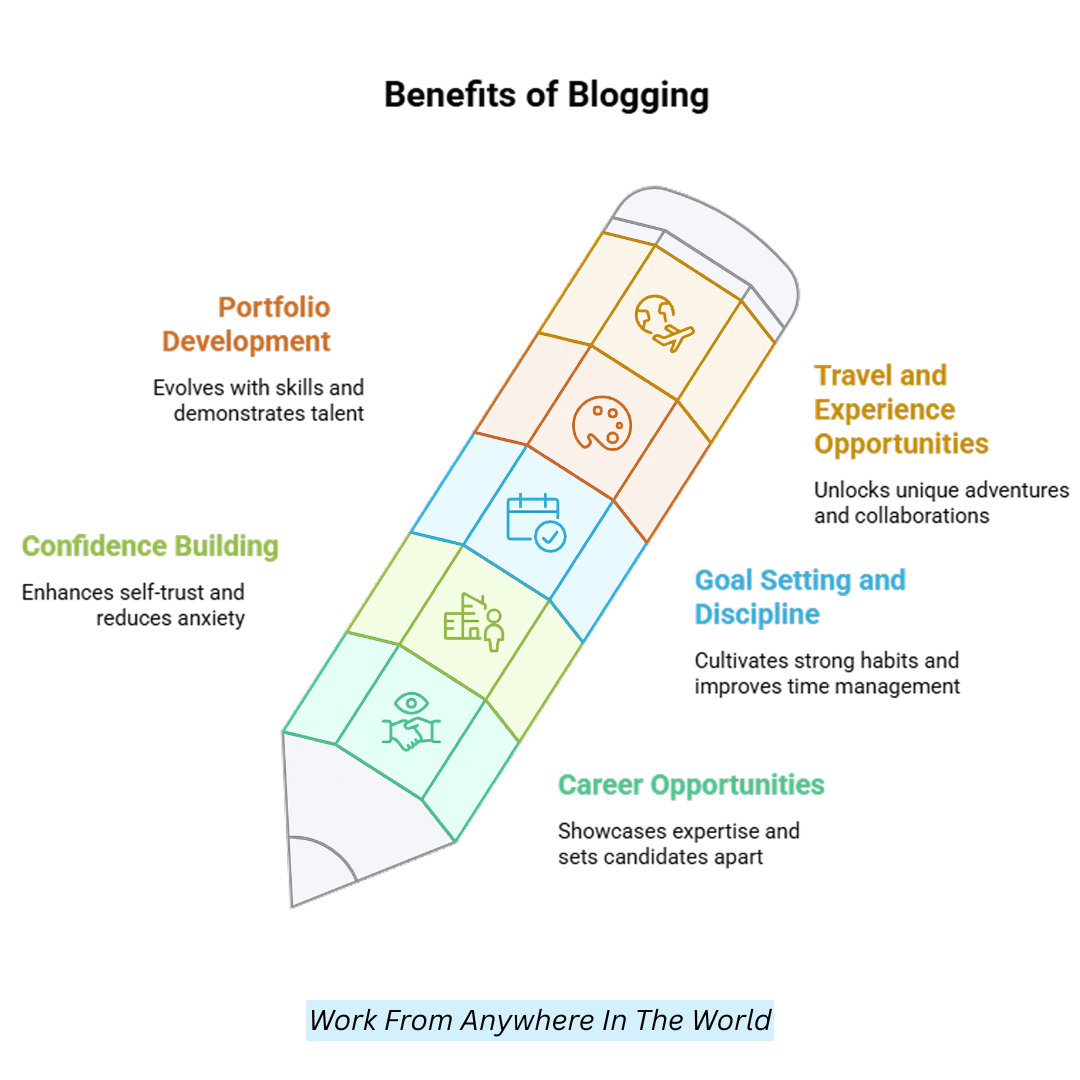
16. Help Others Solve Problems
Every blog post offers a chance to provide value, whether you’re solving a tech problem, teaching a new recipe, or offering advice.
Sharing your knowledge helps others improve their lives, complete tasks more easily, or feel less alone. Helpful content is the heartbeat of the internet, and readers always appreciate it.
Why It’s Powerful
According to Demand Metric, 70% of people prefer getting information from blogs over traditional ads. Helpful content builds trust, engagement, and loyalty.
When you solve problems through your blog, you position yourself as a valuable resource, boosting your credibility and creating real-world impact and meaningful connections.
17. Explore And Validate Business Ideas
Thinking of launching a product or service? Use your blog to test the waters. Share ideas, run polls, and ask readers for feedback.
Blogging lets you assess interest without significant investments. It’s a safe space to innovate, learn from your audience, and build something people want or need.
Why It’s Powerful
CB Insights reports that 35% of startups fail due to a lack of market need. Blogging allows you to validate demand before investing heavily.
Your readers’ feedback becomes real-time market research—saving time, money, and helping you launch with confidence and clarity based on genuine interest and engagement.
18. Gain Media And Press Exposure
Blogging increases your chances of getting featured in the media. Journalists often search for niche experts and thought leaders online.
If your blog ranks well and shares quality insights, it can lead to interviews, podcast invites, guest articles, and media quotes—expanding your influence beyond your own platform.
Why It’s Powerful
Cision’s State of the Media Report notes that 61% of journalists use blogs to find story ideas or sources. A credible blog gives you media visibility and social proof.
These third-party endorsements boost brand authority, site traffic, and open doors to broader audiences and opportunities.
Wealthy Affiliate – Mini Review (2025)
If you’ve ever thought about turning your blog, passion, or niche into an online business,
Wealthy Affiliate (WA) is one of the most beginner-friendly platforms I’ve used.
It combines step-by-step training, website hosting, SEO research tools,
and an active community all in one place.
What I like most: you can start free (no credit card needed),
explore lessons, test the tools, and connect with other entrepreneurs
before upgrading. WA isn’t a “get rich quick” scheme — it’s a platform where success comes
from consistent effort and applying what you learn.
19. Teach, Inspire, And Lead
One of the most compelling reasons to start a blog is its power to uplift and guide others. A blog isn’t just for sharing information—it’s a platform to mentor, inspire, and empower your readers.
Whether through stories, tutorials, or encouragement, your blog becomes a space for positive change and personal leadership.
Why It’s Powerful
According to the Edelman Trust Barometer, 63% of readers trust people like themselves more than experts. Blogs feel personal and authentic.
When you consistently show up with insights and encouragement, you build influence and become a trusted voice who can lead, inspire action, and even spark transformative movements.
20. Leave A Digital Legacy
Your blog is a store of your ideas, originality, and principles, not just a selection of postings. Unlike fleeting social content, blog articles can live on for decades.
It's a powerful way to share your experiences with future generations and leave something meaningful behind.
Why It’s Powerful
A 2023 Pew Research Center report found that 90% of internet users consider online content part of their legacy. A blog preserves your story, passions, and lessons. It becomes your digital footprint that can educate, comfort, and inspire even after you’re gone.
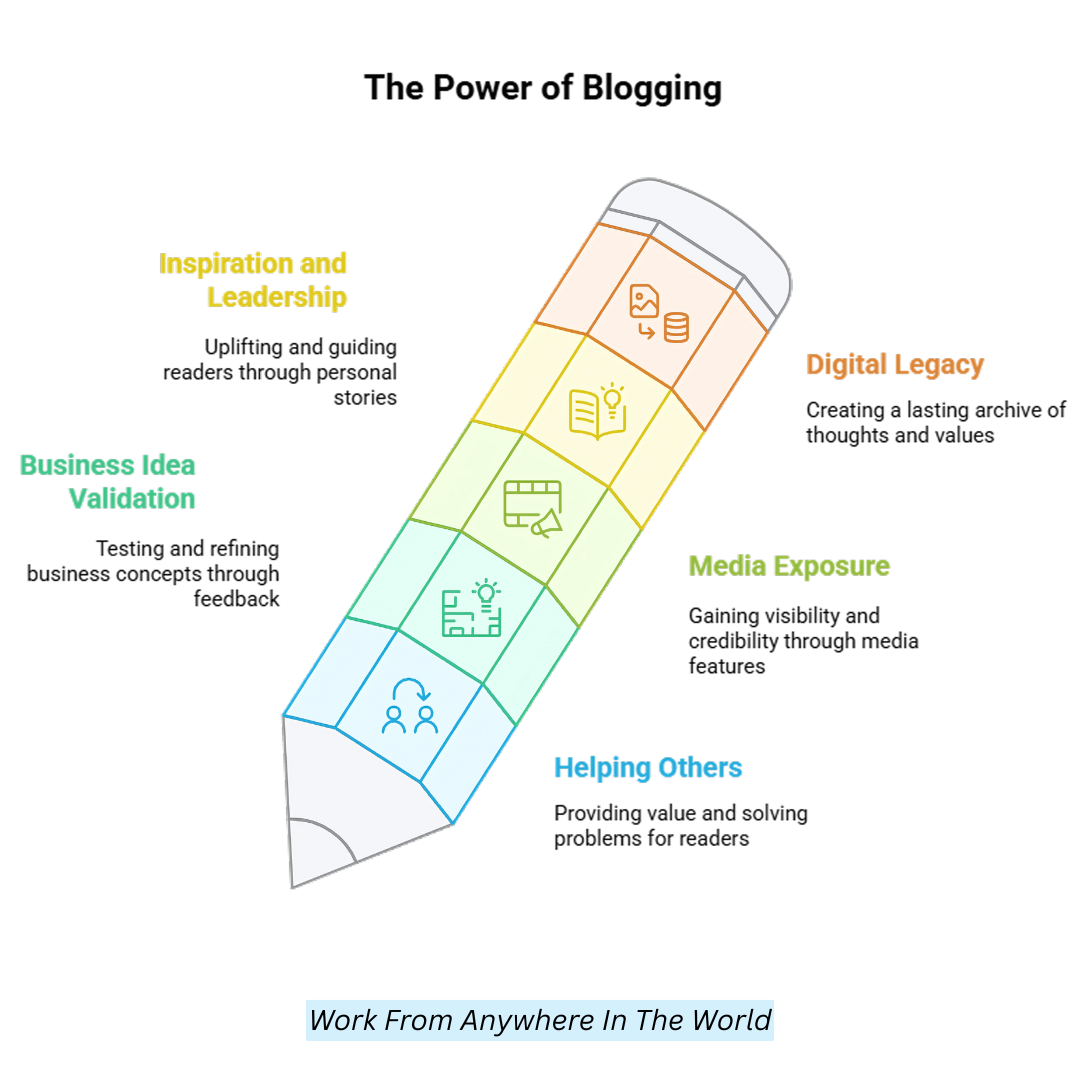
What Topics Are Best For Blogging?
The best blogging topics usually depend on your interests, audience, and goals, but here are some popular and evergreen categories that consistently perform well:
1. Personal Development & Self-Improvement
Share tips on productivity, mindfulness, and motivation. This niche attracts a broad audience interested in growth. Monetize through courses, ebooks, coaching, and affiliate products. Potential monthly incomes range from $500 to $5,000+.
2. Health & Wellness
Write about nutrition, fitness, mental health, and holistic living. Sponsored posts, affiliate supplements, and online coaching can generate income. Popular health blogs often earn $1,000 to $10,000 monthly, depending on audience size and offers.
3. Technology & Gadgets
Review the latest tech and provide tutorials. Affiliate marketing, sponsored content, and ad revenue are key income sources. Successful tech bloggers can earn between $1,000 and $15,000+ per month.
4. Travel & Lifestyle
Create travel guides, tips, and lifestyle advice. Earnings come from sponsored trips, affiliate bookings, and ads. Top travel blogs can earn $500 to $10,000 monthly or more, depending on reach.
5. Finance & Money Management
Offer budgeting tips, investing advice, and side hustle ideas. High-paying affiliate programs and consulting can boost income. Finance blogs earn $2,000 to $20,000+ monthly due to lucrative partnerships.
6. Food & Recipes
Share recipes, cooking tips, and restaurant reviews. Monetize through sponsored posts, ads, and cookbooks. Popular food blogs earn anywhere from $500 to $8,000 monthly, depending on traffic and partnerships.
7. Parenting & Family
Write about parenting advice, activities, and education. Sponsored posts and affiliate marketing for baby products are common. Income ranges from $300 to $5,000+ monthly for engaged family audiences.
8. DIY & Crafts
Offer step-by-step guides for home projects and crafts. Monetize with sponsored posts, affiliate links to supplies, and selling patterns. DIY blogs typically earn $300 to $6,000 monthly based on niche and audience.
9. Career & Business
Provide job tips, entrepreneurship advice, and productivity hacks. Income streams include coaching, courses, and affiliate tools. Top career/business blogs can earn $1,000 to $12,000+ monthly.
10. Hobbies & Entertainment
Cover books, gaming, movies, and music reviews. Monetize with ads, sponsorships, and affiliate sales. Earnings vary widely but often range from $200 to $5,000+ monthly, depending on niche and engagement.
FAQ
Q1: Is Blogging Still Worth It In 2025?
Absolutely. With billions of readers and numerous monetization avenues, blogging remains valuable.
Q2: How Much Does It Cost To Start A Blog?
Starting costs can be minimal, especially with free platforms. Investing in a domain and hosting can enhance professionalism.
Q3: Do I Need Technical Skills To Start A Blog?
Not always! WordPress, Wix, and Blogger are just a few user-friendly blogging platforms requiring little to no technical experience.
Q4: How Often Should I Post On My Blog?
Consistency is key. Start with 1-2 weekly posts and adjust based on your schedule and audience engagement.
Q5: Can Blogging Make Money?
Yes! Many bloggers earn through ads, sponsored posts, affiliate marketing, selling products, or offering services.
Conclusion
Now that you know the top reasons to start a blog, it’s time to take action and begin your journey. Blogging offers endless opportunities to express yourself, build a community, and achieve your goals.
Don’t wait—embrace a blog's exciting possibilities and watch your passion grow into something truly remarkable. Your blogging adventure starts today!
I trust you enjoyed this article on the [Blog Post Title]. Please stay tuned for more insightful blogs on affiliate marketing, online business, and working from anywhere in the world.
Take care!
— JeannetteZ
💬 Your Opinion Is Important To Me
Do you have thoughts, ideas, or questions? I’d love to hear from you. Please leave your comments below or email me directly at Jeannette@WorkFromAnywhereInTheWorld.com.
📚 More Work From Anywhere Reads
🚀 Ready to Build a Business You Can Run from Home
Or from Anywhere in the World?
Imagine creating income on your terms — from home, a cozy café, or wherever life takes you.
With the right tools, training, and community support, it’s entirely possible.
Start your own online business for free — no credit card needed.
Disclosure
This post may contain affiliate links. As an Amazon Associate and participant in other affiliate programs, I earn from qualifying purchases at no extra cost to you. Please read my full affiliate disclosure.

